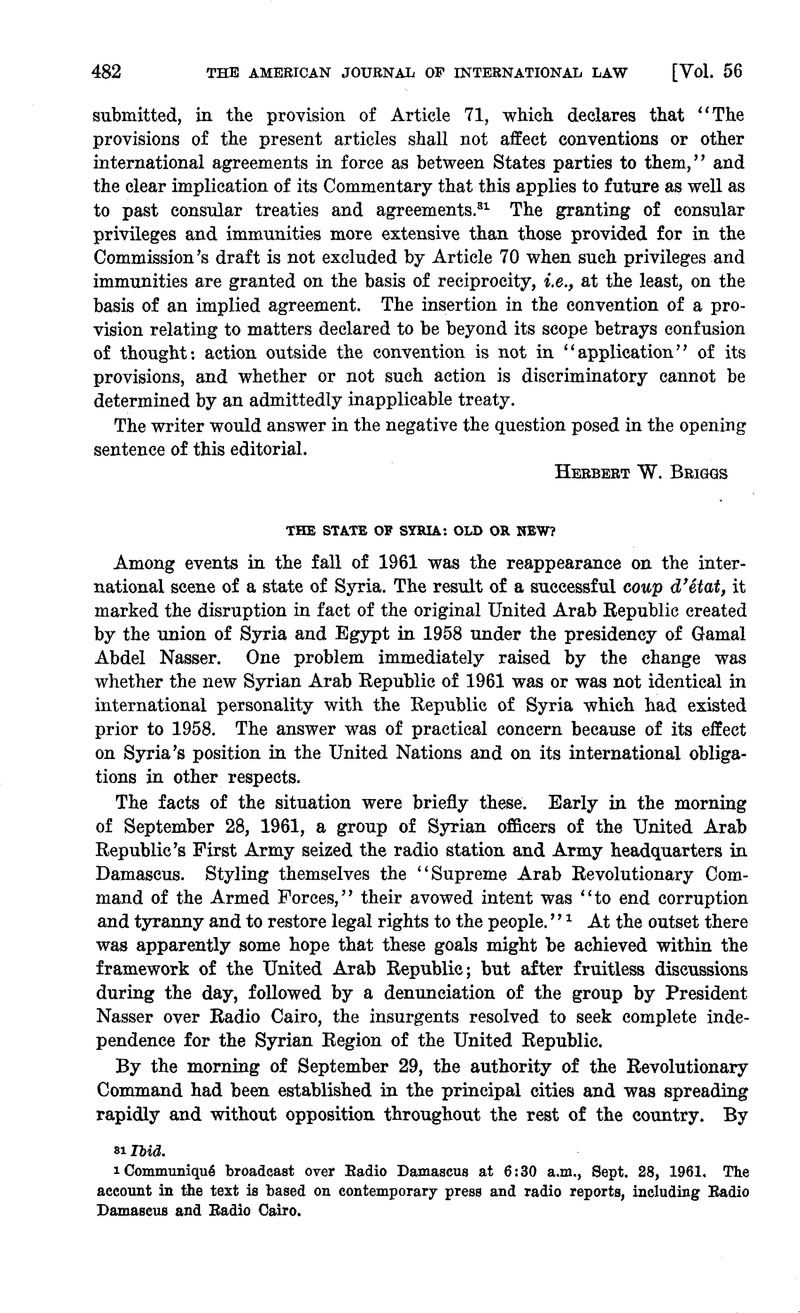Published online by Cambridge University Press: 28 March 2017

1 Communiqué broadcast over Radio Damascus at 6:30 a.m., Sept. 28, 1961. The account in the text is based on contemporary press and radio reports, including Radio Damascus and Radio Cairo.
2 Communiqué1 No. 17 of the Revolutionary Command, as broadcast over Radio Damascus.
3 Decree No. 1, published in the Official Gazette of the Syrian Arab Republic, No. 1, Oct. 5, 1961.
4 The text of the provisional (constitution was printed in the Official Gazette, No. 11, Nov. 15, 1961.
5 Text of U. S. announcement in 45 Dept. of State Bulletin 715 (1961).
6 In taking his seat, the Syriasn delegate referred to the United Arab Republic as “the eldest sister... which will always continue to be dear to us.” Egyptian Gazette (Cairo), Oct. 29, 1961.
7 Arts. 1 and 5 of the Treaty of May 15, 1955, (5 U. S. Treaties 2369, 49 A.J.I.L. Supp. 163 (1955); Kunz, , “The State Treaty with Austria,” 49 A.J.I.L. 535, 541 (1955)Google Scholar. After World War I, on the other hand, there was considerable difference of opinion on the question whether the new Austrian Republic was the same international person as the prewar state. 1 Oppenheim, International Law (8th ed., by Lauterpacht) 155, note. Cf. the case of The Netherlands, cited note 15 below.
8 This result may be contrasted with the subsequent “federation” on March 8, 1958, of Yemen with the United Arab Republic under the style of the United Arab States, in which both parties retained their international identities. The federation was never more than nominal, and was itself dissolved on U.A.R. initiative as an aftermath of the Syrian breakaway.
9 U.N. Doc. A/4914, Oct. 9, 1961. In an earlier message of Sept. 30, Dr. Kuzbari had notified the President of his appointment as Prime Minister and Foreign Minister of the Syrian Arab Republic. U.N. Doc. A/4913, Oct. 9, 1961.
10 United Nations, 1 Repertory of United Nations Practice 175.
11 Ibid. 176. In June, 1960, the Federation of Mali, comprising the former French territories of Senegal and French Sudan, was recommended to the Assembly by the Security Council for U.N. membership. Before the Assembly acted, the Federation broke up into the two independent republics of Senegal and Mali. Both were admitted as new Members by the Assembly on Sept. 28, 1960, without any further recommendation from the Security Council. It thus appears that, while a successor state cannot inherit membership, it can benefit from the recommendation for membership made with respect to its predecessor.
12 U.N. General Assembly, Provisional Verbatim Record of the 1035th Meeting, U.N. Doc. A/P.V. 1035, Oct. 13, 1961, pp. 2–3.
13 Ibid., 1036th Meeting, U.N. Doc. A/P.V.1036, Oct. 13, 1961, pp. 21–22.
14 Jones, “State Succession in the Matter of Treaties,” 24 Brit. Yr. Bk. of Int. Law 360, 365 (1947); but practice is not wholly consistent: see 2 Hyde, International Law 1529 ff. (2d ed., rev.).
15 At the time of Austria’s absorption by Germany in 1938 the Department of State apparently viewed American treaties with Austria as having been terminated. 2 Hyde, op. cit. 1533. Currently, however, several pre-war treaties with Austria are listed by the Department as being in force. Department of State, Treaties in Force January 1, 1961, pp. 8–10; McIntyre, Legal Effect of World “War II on Treaties of the United States 321. The 1955 Austrian State Treaty contained no provisions on the status or revival of pre-war treaties. By way of contrast, mention may be made of the treaty of October 8, 1782, between the United States and the United Netherlands. The latter state was afterward subjugated by Napoleon and in 1815 incorporated in the larger Kingdom of The Netherlands. Because of this history, it was eventually agreed that there had been such a substantial change in party that the treaty had lost its binding force. 5 Moore, Digest of International Law 344–345.
16 As quoted in Department of State, Treaties in Force January 1, 1961, p. 178. Assurances to the same effect were given in a note addressed by the U.A.B. Ministry of Foreign Affairs to the Secretary General of the United Nations on March 1, 1958.
17 “We shall respect all international commitments, as can be gathered from the Ministerial Declaration of the Government of the Republic.” Mr. Chalaoui (delegate of Syria) in the General Assembly, Oct. 13, 1961. U.N. Doc. A/P.V.1036, Oct. 13, 1961, p. 22.
18 58 Stat. 1491; U. S. Executive Agreement Series, No. 434.
19 43 Stat. 1821; U. S. Treaty Series, No. 695; 19 A.J.I.L. Supp. 1 (1925)
20 Department of State, Treaties in Force January 1, 1961, p. 180.
21 Jones, loc. cit. note 14 above, p. 366.